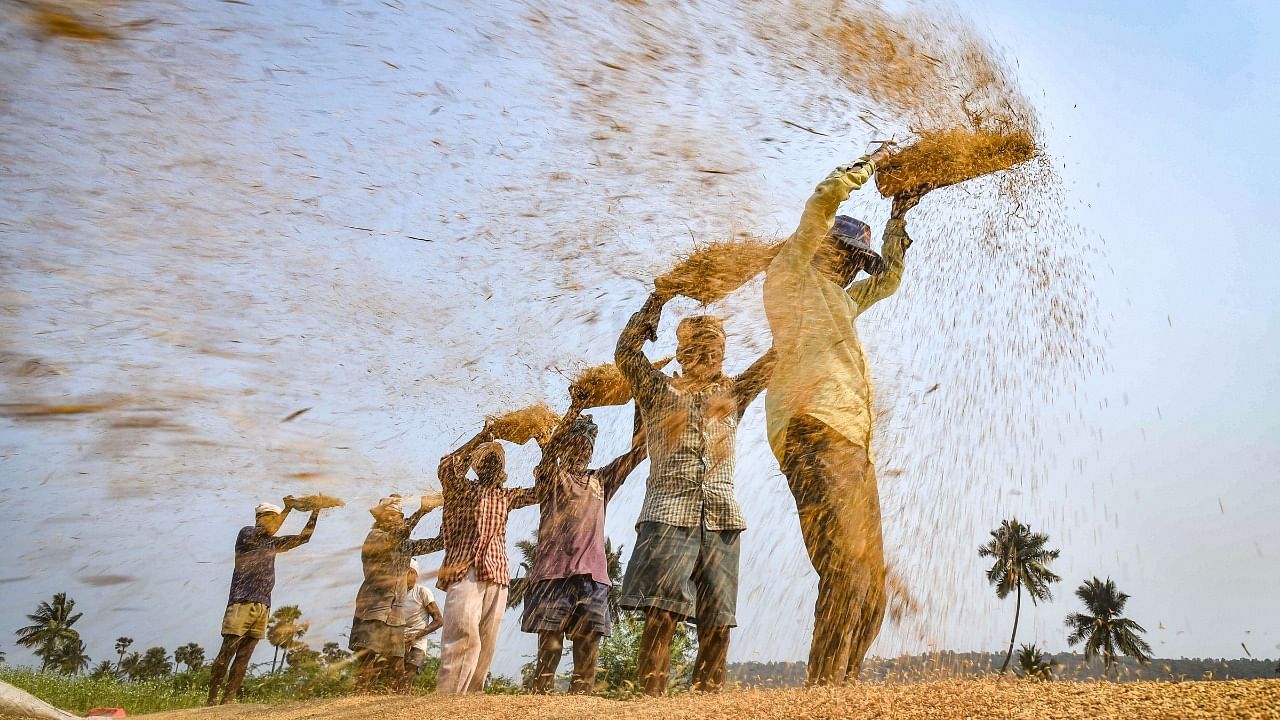
Farmers winnow rice grains at a field.
Credit: PTI File Photo
Hubballi: Karnataka’s foodgrain production (cereals and pulses) is estimated to decrease by 31 lakh tonnes this year compared to the previous year. Paddy is anticipated to see the highest fall, with estimates showing a plunge from 65 lakh tonnes to 38 lakh tonnes .
The steep decline is attributed to the low water storage in the Tungabhadra and Kaveri basins, critical paddy-growing regions. The area under paddy cultivation has shrunk by 4 lakh hectares due to the state government’s restrictions in these basins.
Karnataka is set to see the lowest paddy harvest in over a decade.
Based on the agriculture department’s second advance estimates, the state is anticipated to experience a deficit in the production of various cereals and pulses, and not just paddy. Only jowar, tur and Bengal gram are expected to buck the trend.
In a typical year, Karnataka harvests 129 lakh tonnes of cereals and pulses. The previous year saw an increase to 143 lakh tonnes. However, the production is estimated to slump to 112 lakh tonnes this year.
This year’s rainfall deficit has predominantly impacted cereal cultivation. While jowar production is estimated to increase by 60,000 tonnes compared to last year, ragi is projected to witness a drop of around 3 lakh tonnes.
“Erratic rainfall led to a challenging kharif season, and the total failure of rabi crops has dealt a severe blow to both the farmers and the state’s production,” said BK Desai, Director of Research at University of Agriculture Sciences, Raichur.
Several farmers who shifted from traditional crops to those requiring less water have not seen any significant improvement. “The rain and the government cheated us,” said Ramappa Menasinakai, a farmer in Gangavathi who switched to cultivating green gram from paddy. He said the yield was merely 65% of what was anticipated. The water released from the Tungabhadra reservoir was not sufficient for green gram, he added.
The production of oil seeds is also expected to decline. From 14 lakh tonnes last year, the production of groundnut, sesame, sunflower, mustard and other crops is projected to decrease to around 10 lakh tonnes this year.
Experts fear that this year’s low yield might push the kitchen budget northwards and also impact the state government’s ambitious Anna Bhagya scheme.
“In the current scenario, the government has to look for foodgrains outside the state,” said a senior faculty member at the University of Agriculture Sciences, Dharwad.
However, Agriculture Department Director GT Putra says Karnataka would not encounter an acute shortage this year. “While the rabi and kharif yields haven’t met expectations, we are hopeful that by the third and fourth advance estimates, we will minimise the foodgrain deficit,” he said.
Farmers have been given a contingency plan to minimise their losses and grow alternative crops. The state government will ensure that the prices of essential foodgrains don’t rise sharply, he said.